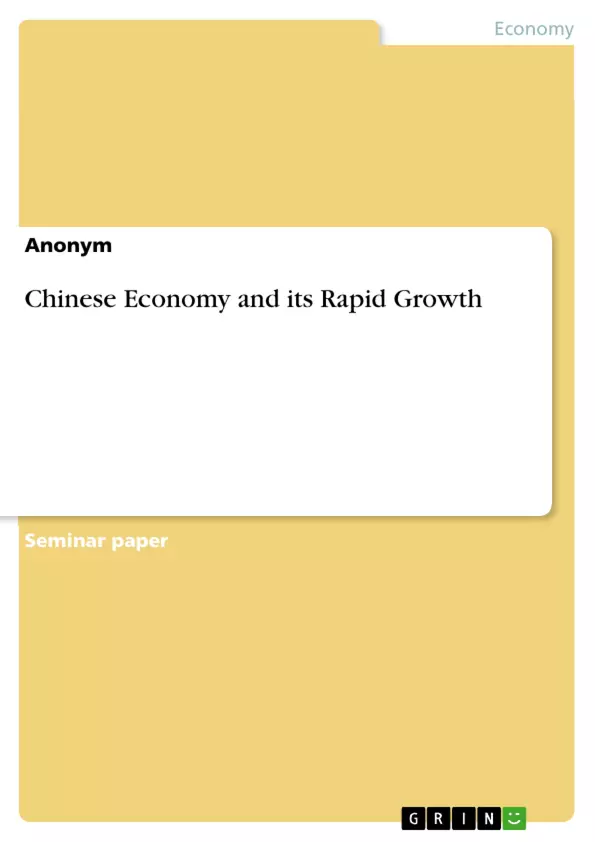The subject of this assignment is the Chinese economy and the focus is on the extraordinarily rapid growth of it. How could China, with the largest population on earth and its equally diverse population, go from being an emerging economy with an average income of 54 US dollars per year, to the economic power it is today? First, the country will be presented as such, then we consider the economic growth and the sectors. In the third chapter, we focus on the reforms, their impact on the people and the economy. Then, in the next chapter, we will deal with the energy and resources. China's influence in Africa is dealt with in the fifth chapter and the "One Belt One Road" initiative follows in the sixth chapter. Finally, there is a summary with an outlook on the future of China and the global economy.
Das Thema dieser Arbeit ist die chinesische Wirtschaft, und der Schwerpunkt liegt auf dem außerordentlich schnellen Wachstum dieser Wirtschaft. Wie konnte sich China mit der größten Bevölkerung der Erde und seiner ebenso vielfältigen Bevölkerung von einem Schwellenland mit einem Durchschnittseinkommen von 54 US-Dollar pro Jahr zu der Wirtschaftsmacht entwickeln, die es heute ist? Zunächst wird das Land als solches vorgestellt, dann betrachten wir das Wirtschaftswachstum und die Sektoren. Im dritten Kapitel konzentrieren wir uns auf die Reformen und ihre Auswirkungen auf die Menschen und die Wirtschaft. Im nächsten Kapitel geht es dann um Energie und Ressourcen. Chinas Einfluss in Afrika wird im fünften Kapitel behandelt und die "One Belt One Road"-Initiative folgt im sechsten Kapitel. Abschließend gibt es eine Zusammenfassung mit einem Ausblick auf die Zukunft Chinas und der Weltwirtschaft.
Inhaltsverzeichnis (Table of Contents)
- Introduction of China
- Introduction
- People
- Religion
- Demography
- Economic growth and their sectors
- Economic growth
- General considerations
- Economic growth
- The role of the Government
- Economic policies
- Chinas sectors
- Agriculture and livestock
- Manufacturing of China
- Banks and stock trading
- Economic growth
- Chinese economic reforms since 1978.
- Energy and mineral resources
- Energy industry.
- Resources and power..
- Minerals of China........
- China's influence in Afrika....
- Ports in Africa under Chinese influence..
- The New Silk Road.
- Opportunities for trade and world order..
- Criticism......
- The European counterpart to the Silk Road
Zielsetzung und Themenschwerpunkte (Objectives and Key Themes)
This assignment delves into the Chinese economy, specifically focusing on its extraordinary rapid growth. It explores the transformation of China from an emerging economy to a global economic powerhouse, highlighting the factors contributing to this remarkable development. The text delves into China's economic growth and sectors, examines the impact of reforms, analyzes energy and resources, and discusses China's influence in Africa and the implications of the 'One Belt One Road' initiative.
- China's rapid economic growth and its transition from an emerging economy to a global power.
- The role of economic reforms in driving China's growth and their impact on the people and the economy.
- The importance of energy and mineral resources in China's economic development.
- China's growing influence in Africa and its investment in ports and infrastructure.
- The 'One Belt One Road' initiative, its potential for trade and world order, and associated criticisms.
Zusammenfassung der Kapitel (Chapter Summaries)
The first chapter provides an overview of China, covering its geography, demographics, and cultural landscape. The second chapter delves into China's economic growth, examining various sectors and the role of the government in shaping economic policies. The third chapter focuses on economic reforms since 1978, analyzing their impact on the economy and the population. The fourth chapter explores the energy and mineral resources in China, highlighting their significance in the country's development. The fifth chapter discusses China's growing influence in Africa, specifically focusing on Chinese investment in ports. The sixth chapter examines the 'One Belt One Road' initiative, exploring its potential benefits and associated criticisms.
Schlüsselwörter (Keywords)
This text examines China's economic growth, its transformation from an emerging economy to a global power, the role of economic reforms, the significance of energy and mineral resources, China's influence in Africa, and the 'One Belt One Road' initiative. Key themes include economic development, globalization, infrastructure investment, international trade, and geopolitical influence.
- Quote paper
- Anonym (Author), 2022, Chinese Economy and its Rapid Growth, Munich, GRIN Verlag, https://www.hausarbeiten.de/document/1262969


